Pretty peonies are the quintessential romance flowers. They come by their popularity as a wedding flower and Instagram-worthy showpieces because of their truly breathtaking form and sweet fragrance. This everything guide to peonies covers the history and symbolism of peonies, the different cultivars, as well as how to grow, harvest, and use garden peonies.
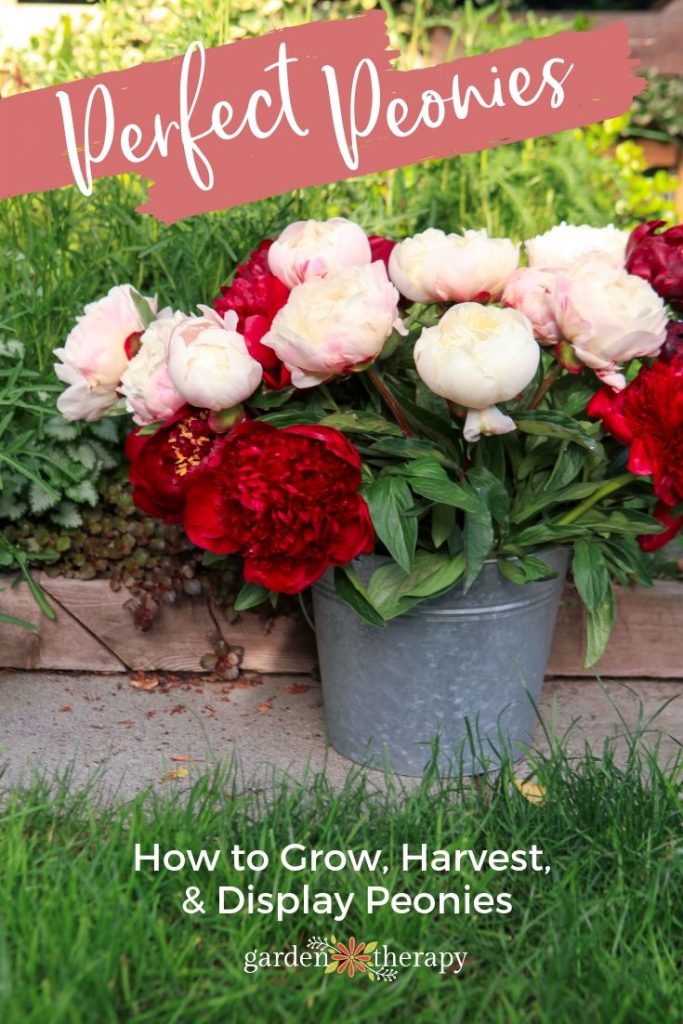
I’ve never met a person who didn’t love peonies. All it takes is one neighbour to grow a beautiful peony flower to make you run out to the garden centre to get your own.
Peonies are incredibly giving flowers once they get established. They bloom large, showy flowers yearly and can remain in your garden for your entire life.
Here’s how to grow peonies and harvest them to brighten up the home.
- Expert Tips for Growing Peonies
- History and Symbolism of Peonies
- Peony Varieties
- Peony Flower Types
- How to Grow Herbaceous Peonies
- Soil and Location
- Light
- Water
- Staking
- Pests
- How to Divide Peonies
- How to Harvest Peonies for Cut Flowers
- How to Arrange Peonies
- Pretty Pink Peony Bath Salts Recipe
- Frequently Asked Questions About Peonies
- More Gorgeous Garden Guides
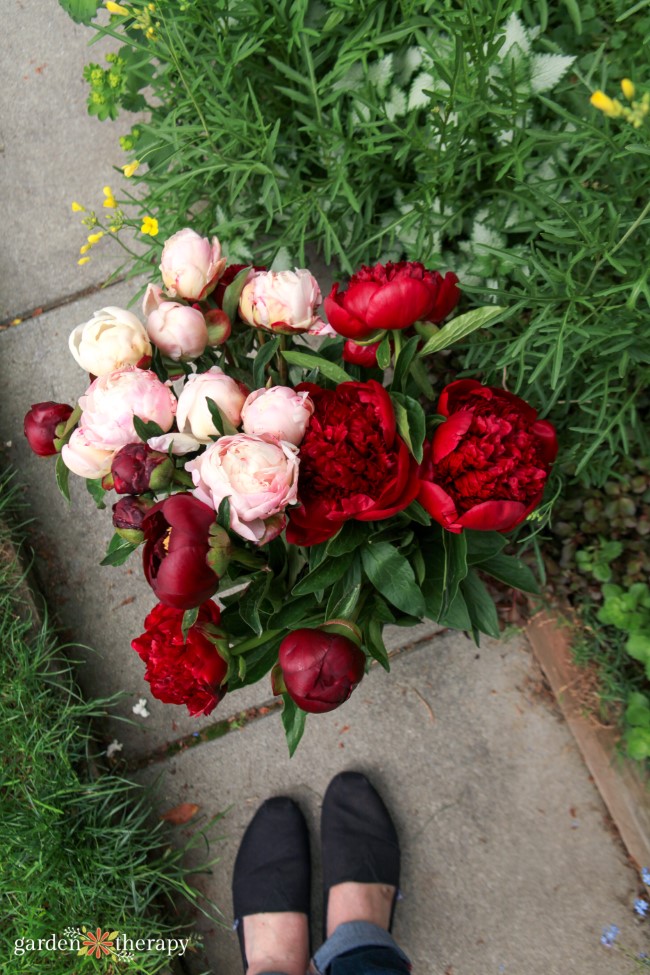
Expert Tips for Growing Peonies
- Plant peonies in full sun, where they can get 6-8 hours of sunlight a day.
- Peony flowers are drought-tolerant and require no additional fertilizer.
- Peonies require staking as the plants can get quite top-heavy when in bloom.
- If it rains, gently shake the water collected in the flowers to stop them from weighing down.
- To cut flowers, harvest them when they’re still a squishy bud, known as the marshmallow stage.
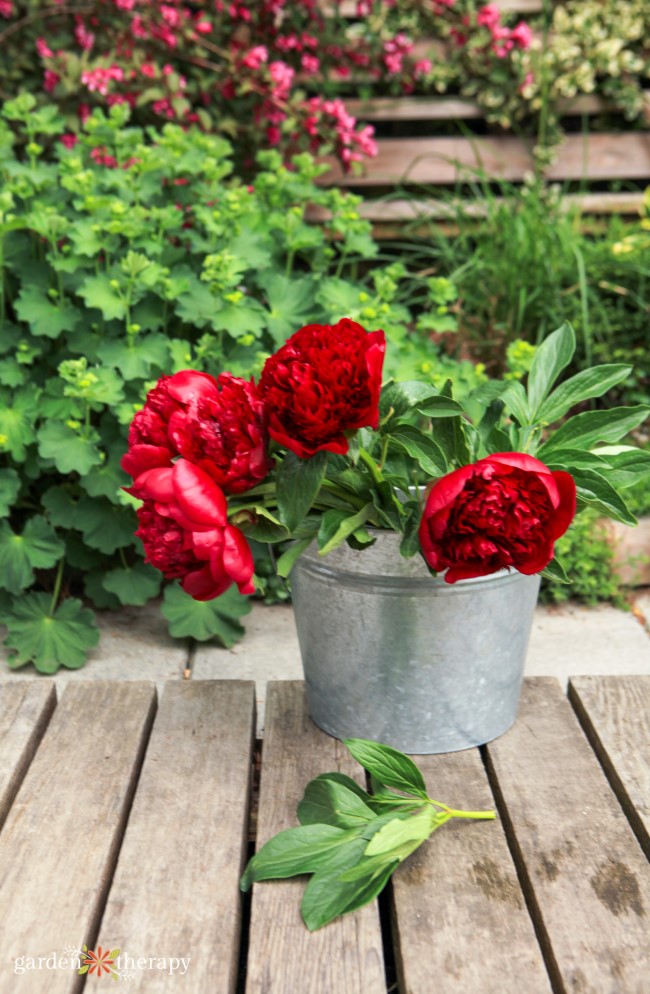
History and Symbolism of Peonies
In Eastern cultures, the peony is known as the “king of flowers” and a symbol of wealth, honour, and beauty. Peonies are often seen at weddings and are sometimes reserved for royalty. It was the national flower of China for over 250 years before being replaced.
In Greek mythology, it is said that peonies are named for Paeon, a physician to the gods, while there are other stories of beings turned into peonies out of jealousy or immortality. Many intertwined tales around the world of peonies follow the themes of high value as a medicinal plant and as a striking beauty.
In both European and Asian countries, these beautiful flowers were traditionally grown for their medicinal properties. Paeonia lactiflora is often used in Chinese herbal medicine. Asian countries use a decoction made from the root to treat inflammatory diseases like rheumatoid arthritis, lupus, hepatitis, muscle cramping, and fever.
The flower buds and petals are often used as a tea. Peony petals look beautiful served raw in salads but the buds and pedals can also be fried.

Peony Varieties
There are thousands of different cultivars of peony that are divided into three major groups.
Herbaceous or Garden Peonies are sun-loving garden perennials which include species such as the medicinal Paeonia lactiflora.
They are low maintenance in Zones 2 to 8 and require little water once established. They can be an investment to get started in the first few years, but after that, they will require little maintenance to bloom prolifically for many years to come.
Tree Peonies (Paeonia suffruticosa) grow in Zones 4 to 9 and bloom a bit earlier than garden peonies (April and May).
The stems are woody and stay above ground all year, growing 4 to 7 ft tall with beautiful foliage and enormous flowers that can be up to 10 inches across.
Itoh Peonies are a hybrid of garden peonies and tree peonies. They grow in Zones 4 to 9 and bloom in June.
Like many hybrids, these plants are bred for the best qualities of their parents. With Itoh peonies, you can find the prettiest flowers, the most striking foliage, and the most easy-going habit. Itoh peonies can be expensive, but you’ll know why when you see them in the garden.
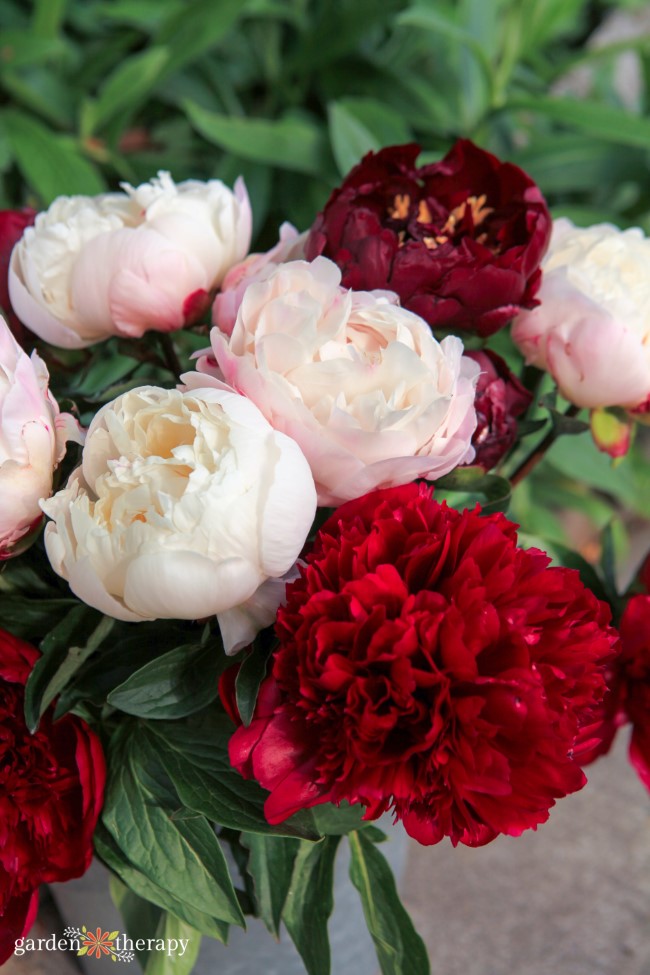
Peony Flower Types
There are six types of peony flower forms that peonies are known for, each striking and showy in their own way:
- single
- semi-double
- double
- bomb
- Japanese
- anemone
The single, semi-double, Japanese, and anemone forms grow petals around colourful stamens and pistils. In the double and bomb forms, the blooms are full of ruffled petals, and no pollen is visible.
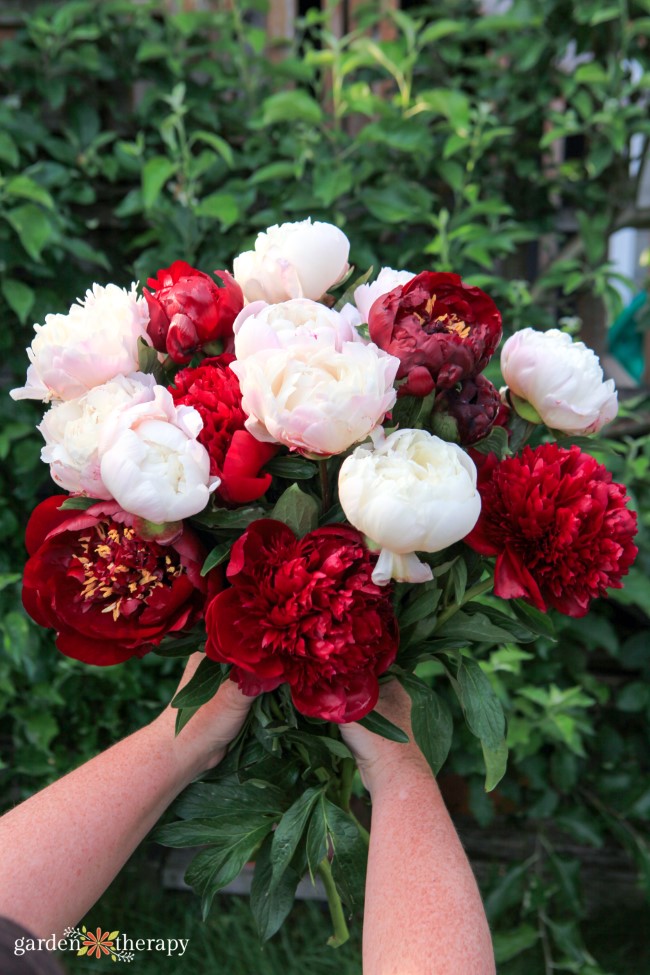
How to Grow Herbaceous Peonies
These cool-climate perennials thrive in Zones 2 to 8 and bloom in late spring, generally between April and June. Here’s how to grow peonies!
Soil and Location
Plant peonies where you plan to keep them. They take a little while to get established. If planting from bare roots, it can take three years before they provide plenty of blooms.
Potted peonies will bloom faster. But still, they like to be established in the garden to produce the most blooms. So once you set them in place, they could be happy to produce flowers for well over 50 years.
But every time peonies get moved, they have to re-establish themselves. Garden peonies aren’t picky about soil, but they do like to have good drainage.
Light
To flower well, these sun-lovers need at least six hours of sun in the spring and summer months. They also require cool soil in the winter to stimulate spring growth.

Water
Peonies are drought-tolerant and don’t require additional fertilizer to bloom. Adding compost as a topsoil dressing annually should be enough to build healthy soil and keep peonies happy.
While the plants are sturdy, the flowers are more delicate. Overhead watering and heavy rain can be too much for the blooms, knocking them over and breaking the stems.
After the rain, head out to the garden and gently shake each one of the blooms to release the weight of water captured inside. This will help them to perk back up.
For those blooms that can’t be saved, cut the stems and bring the flower into the house to enjoy in a vase.
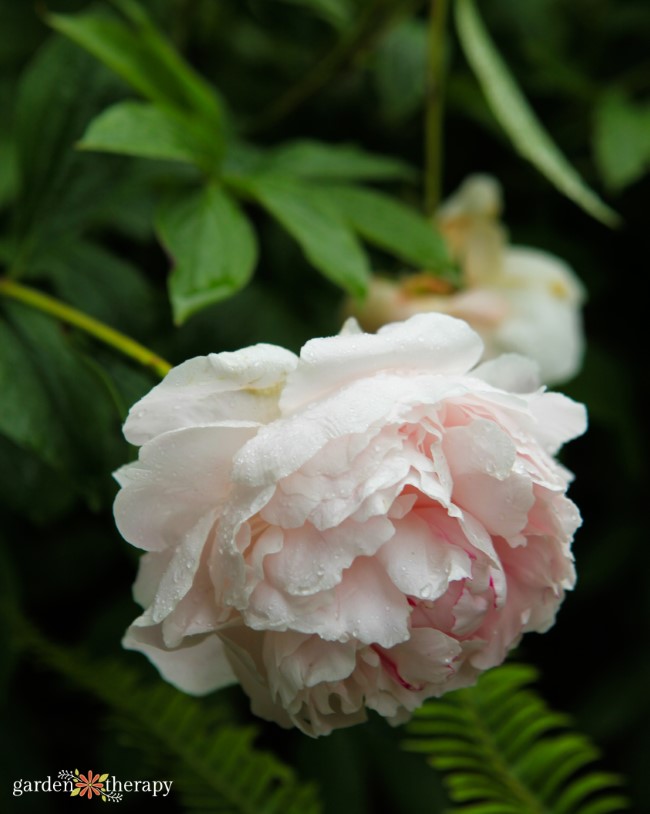
Staking
Peonies’ giant, fluffy blooms get heavy, so many peony plants require staking. There are commercial peony stakes that you can purchase, but my favourite option is a peony chair.
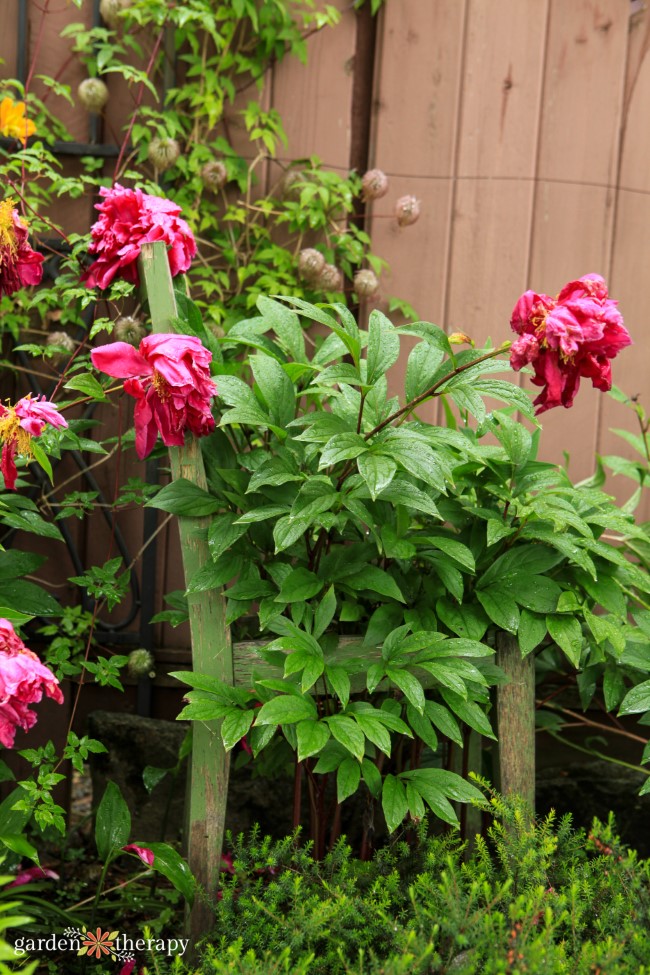
Around my eclectic East Vancouver neighbourhood, it’s not uncommon to see a seatless chair frame standing in the garden beds to hold up peonies. As we live in a rainy climate, it’s absolutely necessary to have something strong to hold those blooms up.
Otherwise, this is what happens!
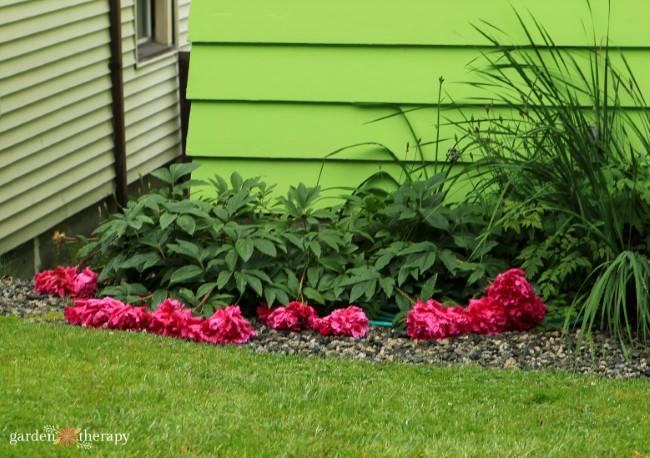
Pests
Pests are generally not a problem, even though you may see ants on the peony buds before they open. There’s a common tale that the ants help the peony blooms to open, but the ants are really just drawn to the sweet nectar.
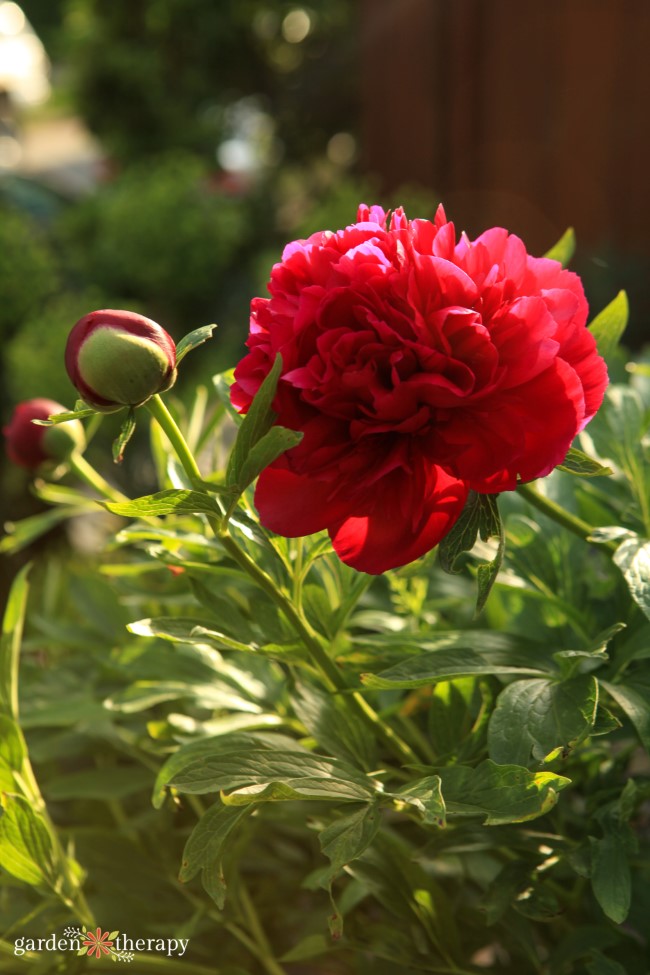
How to Divide Peonies
Divide peonies in the fall after the plant has gone dormant. If you have forgotten, you can also divide them in the early spring before the flowers and leaves appear.
Once the leaves have formed on the stems and flower buds are showing, it’s best to wait until the following fall to divide them. Remember that it takes time for peonies to re-establish when they’re moved or divided and transplanted.

How to Harvest Peonies for Cut Flowers
When cutting flowers for arrangements, to dry for craft projects, or for culinary or medicinal purposes, I put my all-purpose bypass pruners away and instead use the precision blades of floral pruners and snips.
Peonies have sturdy stems, but they are not woody, so light plant pruning shears are perfect. A low-friction coating means the bypass pruners won’t gum up with sap and bits of the plant.
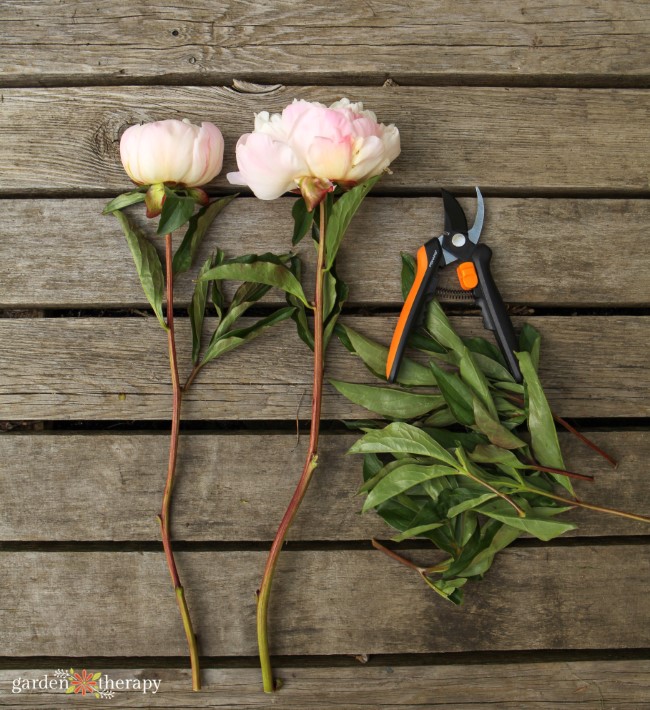
Don’t cut any flowers for the first year the peony is getting established. In the second and third years, if you have to cut a few flowers, do so sparingly.
To make your flowers last long, keep a bucket of cold water with you, and use clean tools to make the cuts. Take a long stem for your peonies but leave at least three sets of leaves on the plant below the cut.
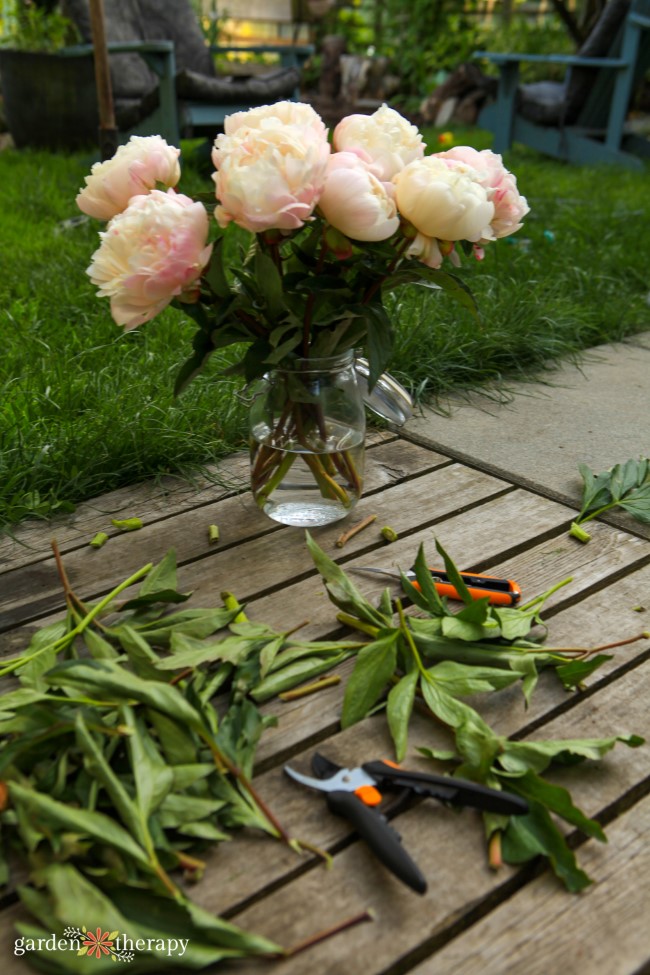
You can cut peonies for arrangements at the bud stage or when the blooms are opening. The earliest you can cut the flowers is when the buds are not quite open but a bit squishy when you pinch them. This is called the “marshmallow” stage because the bud should feel like a springy marshmallow.
Cutting them at this stage ensures that you have the longest-lasting blooms but cut them any earlier, and they won’t bloom in the vase. Immediately put the cut stems in cold water and keep them out of direct sunlight.
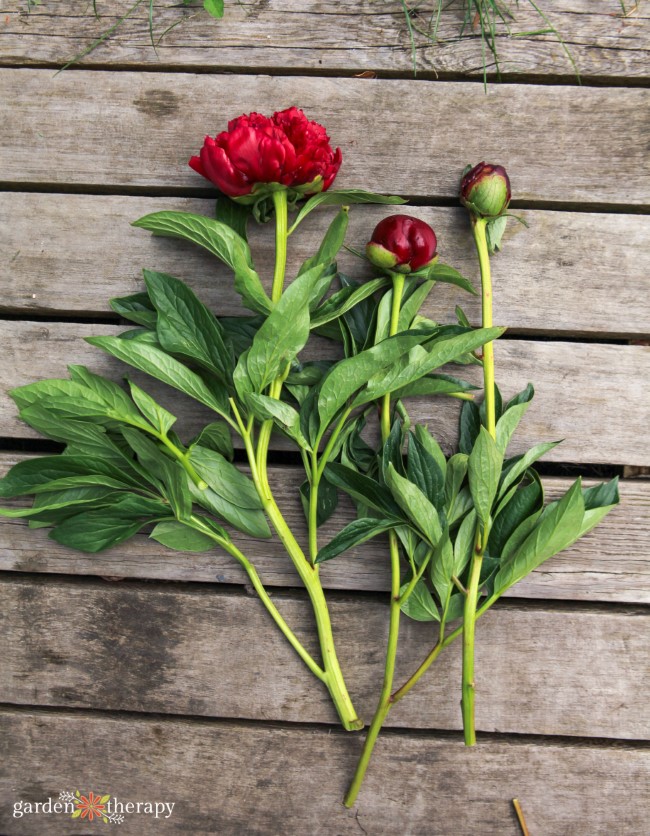
How to Arrange Peonies
You can keep the cut flowers in your fridge or a cool place for a few days to delay blooming. Add the flowers to lukewarm water to speed up blooming and place them in a well-lit area.
Remove any leaves from the stem that will touch the water.
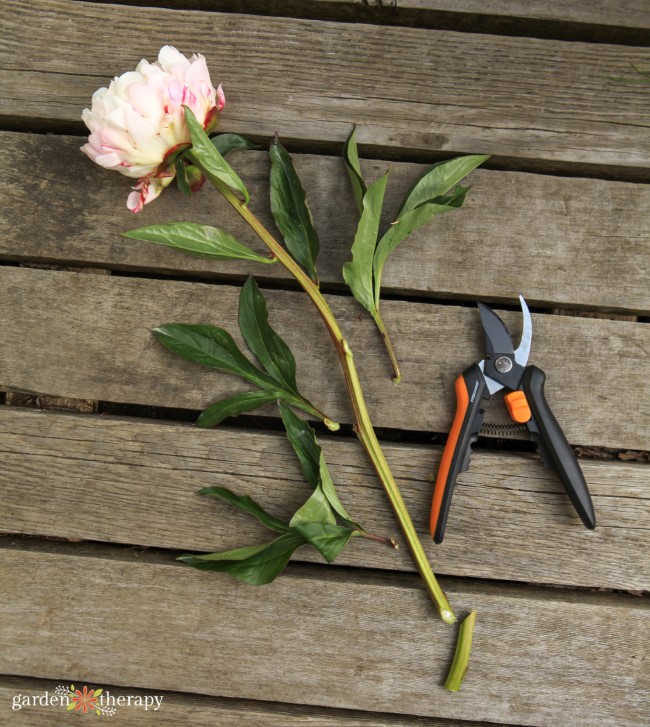
Cut the stems on a diagonal before adding them to a vase of water. They have heavy flower heads, so be sure the vase is heavy enough to hold those big blooms.
Cut the stems so that the blooms sit at an appropriate height just above the top of the vase. Stems that are too tall can cause the vase to topple over.
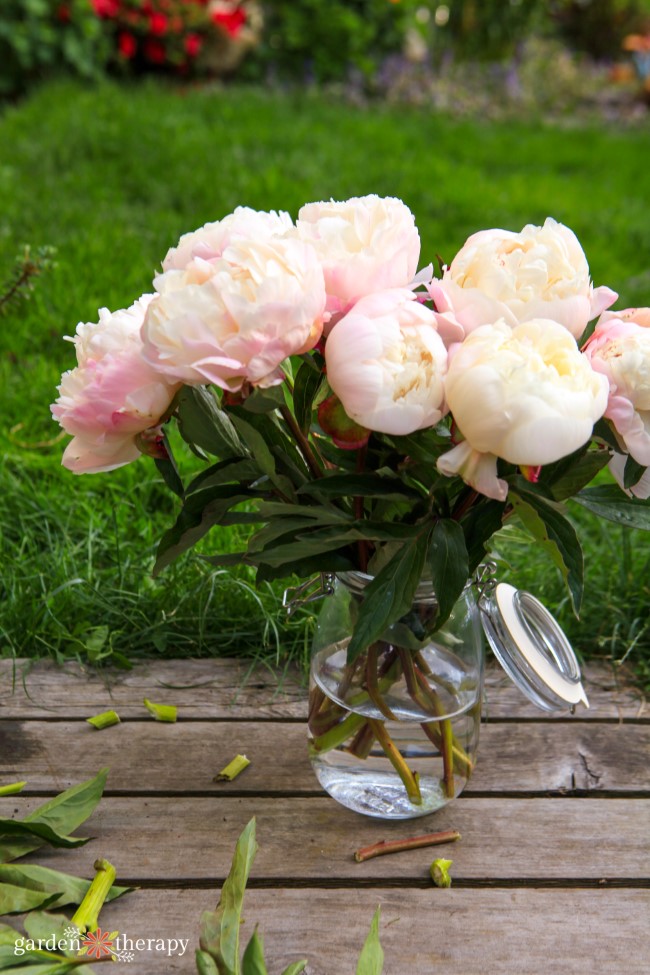
Pretty Pink Peony Bath Salts Recipe
The beauty of peonies doesn’t have to be seasonal. While gorgeous garden peonies only last in the garden for a few weeks and have a showy but limited vase life, you can preserve the beauty all year by drying the petals and making a gorgeous, naturally-scented peony bath salts recipe.
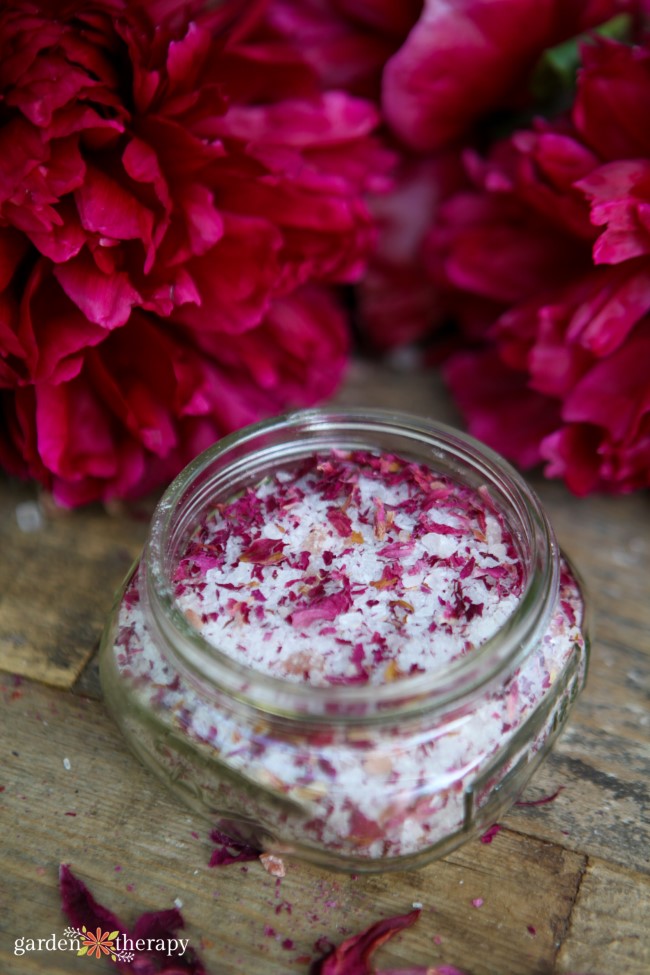
Frequently Asked Questions About Peonies
Tree peonies are first to bloom in mid-spring, typically around and of April to May. Herbaceous peonies bloom next in late spring, around the beginning of June.
Peonies can bloom as early as April through to June. Their blooming time is quite short, only lasting 7-10 days. So enjoy your peony flowers while you can!
Peonies can be planted in spring or fall, but fall is preferable. Do so in September or October. If you missed your opportunity to plant in the fall, you can plant them in early spring as soon as the soil has thawed out enough.
Yes, peonies require full sun of 6-8 hours of direct sunlight a day.
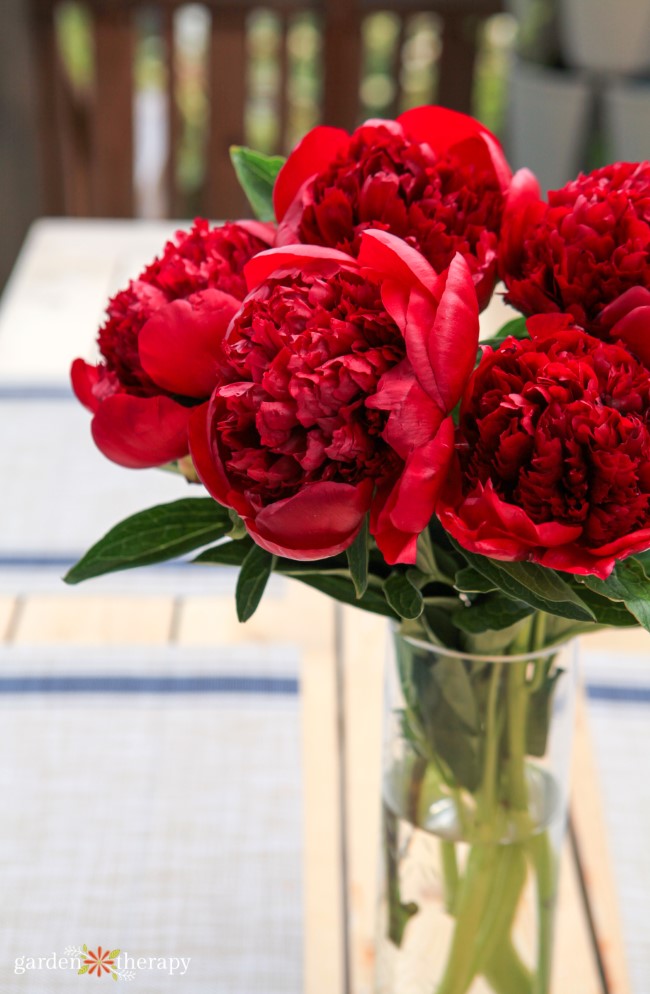
More Gorgeous Garden Guides
- The Essential Guide to Hydrangeas
- Echinacea Guide: Planting, Pruning and Caring for Coneflowers
- Herbal Guide to Hops: Growing, Harvesting, and Using Hops
- The Essential Guide to Growing Lavender
- 10 Fragrant Flowers For a Heavenly-Smelling Garden
- The Essential Guide to Growing Hostas, the Shade Garden Beauty




Thank you for the information on peonies. I have a few that really bloomed well this year. Definitely keeping the recipe for the bath salts to make next year. Will make nice Mother’s Day gifts for my daughters.
I love peonies! You’ve taught me a few things I didn’t know about them, thanks. Great giveaway!
Thank you for all the great information. I recently moved to a new home with several peonies and I’m loving them! I’d like to try the peony bath salts.
I find my attraction to peony prints is quite extensive. For now I have only a patio (that’s full of plants already) so I enjoy what I have and dream of more.
I just heard your interview on the Grow Guide podcast and headed over to check out your website. I LOVE the idea of a peony chair! This is my first summer in a new home with three well established peonies and I’ve wondered how to best support the many blooms that are on their way. A peony chair is the sweetest idea and would fit into my very eclectic Winnipeg neighbourhood so perfectly!